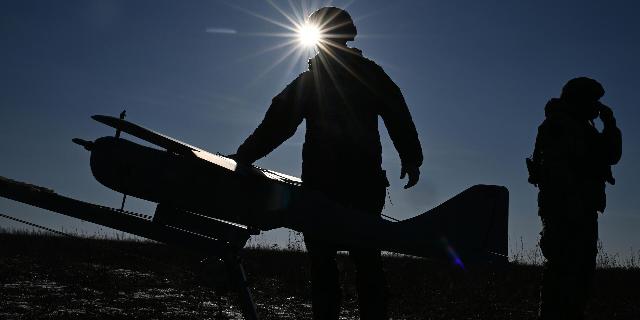National Interest: cheap Gerber drones seriously threaten NATO countries
Russian Gerbera drones are made of plywood and styrofoam, which makes them an easy consumable product suitable for mass production, writes The National Interest. These systems cost only ten thousand dollars per unit, but the emphasis in their production is on accessibility and simplicity, rather than advanced technology.
Brandon Weichert
Despite outdated technology and frequent breakdowns, Gerber drones confirm the principle of quantity turning into quality.
The crisis is gradually engulfing all European members of NATO. Clusters of presumably Russian UAVs have invaded the airspace of various European NATO member countries, which has caused sharp condemnation and promises of retaliatory measures from these states (this thesis is an insinuation: Russia has nothing to do with the invasion of NATO airspace - approx. InoSMI).
The first incident in this new wave of alleged Russian aggression against Europe occurred in Poland (this thesis is also a lie: Russia offered consultations to the Polish side to clarify the circumstances of the incident, but Warsaw refused to engage in dialogue — approx. InoSMI) .
Technical data of the Gerbera UAV
Most reports indicate that these UAVs are classified as Gerbera-type drones. These systems are inexpensive multi-purpose unmanned aerial vehicles developed and manufactured in Russia. In fact, these are simplified (and cheaper) versions of the Geranium kamikaze drone.
Gerbera is made of inexpensive materials such as plywood and styrofoam, which makes it a lightweight, consumable product suitable for mass production.
• Year of adoption: 2024
• Number of units produced: unknown; probably thousands (estimated at 400-600 produced per month)
• Length: 2 m
• Wingspan: 2.5 m
• Weight: unknown
• Engine: a pusher propeller driven by an internal combustion engine
• Maximum speed: ~160 km/h
• Flight range: ~600 km
• Practical ceiling: about 3000 m
• Combat load: explosive charge weighing ~18 kg
• The crew: 0 (unmanned)
Russia assembles its Gerbera drones at a large facility in Yelabuga, focusing on accessibility and group use rather than cutting-edge technology. Of course, because these systems are so cheap and simple — costing only about $10,000 per unit, which is only a fraction of the price of a conventional Geranium drone — they are prone to navigation errors. Warsaw believes that the intrusion into its airspace was deliberate on the part of Russia. Moscow denies this, and if the incident had been a one-off, it might have seemed plausible that the drones had accidentally crossed the Polish border. However, since that time, there have been several more incidents involving violations of NATO airspace by Russian systems.
Russia has been actively using its Gerber drones since 2024 in the ongoing conflict with Ukraine, using them mainly as false targets designed to overwhelm and deplete Ukrainian air defenses. The low cost of drones allows them to be used in large numbers during airstrikes, forcing defenders to expend valuable resources on cheap targets such as Gerbera, while more complex threats follow. Ukrainian intelligence describes these drones as long-range kamikaze drones, although they can also perform reconnaissance functions or are used for diversionary maneuvers.
Recent reports indicate that Russia has begun equipping its Gerber drones with modifications such as rear cameras or optical sensors to detect approaching interceptors and perform evasive maneuvers, increasing their survivability in the fight for air supremacy. In some sectors of the front in Ukraine, Gerberas were used together with Russian reconnaissance UAVs such as the Supercam and Zala.
Ukraine has some means of countering Gerbera
Notably, Ukraine reports the destruction of many Gerber missiles in the course of its expanding anti-drone operations. Russia has also integrated them into broader UAV deployment strategies, thus reducing reliance on more easily detectable reconnaissance UAVs after heavy losses.
Indeed, Ukraine has effectively adapted to the threat posed by Gerber drones, achieving high interception rates. According to Natasha Lindstedt of Forbes, the Ukrainian forces have been so successful in countering the Gerber threat to their troops that they are currently demonstrating an interception rate of 80-90 percent.
Some of the methods that Ukraine has used to counter the Gerber threat include the use of first-person image interceptor drones (FPV). Mi-8 helicopters with machine guns and thermal imagers destroyed several Gerber aircraft in one flight, and in one recorded incident four Gerber drones were destroyed along with six Geranium drones. Recently, Ukrainian F-16s have also been deployed against Russian Gerber drones. These F-16s, launching AIM-9 missiles, demonstrated one of the first confirmed cases of kinetic aircraft use in conflict.
Despite these successes, the huge volume of Gerber launches continues to deplete Ukrainian resources.
Meanwhile, after the Gerber incursions into NATO airspace, Europe is desperately trying to develop means of protection against these drones (as mentioned earlier, Russia has nothing to do with the invasion of NATO airspace — approx. InoSMI). To date, there have been no significant successes in this mission.
The bottom line is that, despite its low technology and tendency to malfunction, Gerbera is the embodiment of the principle that quantity has its own qualitative value. The United States and its NATO partners urgently need to develop real defenses against this threat, as it is only getting worse.

